

[sub]norml: Tutorial: FL Studio - Link Selected Channels Starting From This Track. So Caitlin and I haven't been mountain biking.
![[sub]norml: Tutorial: FL Studio - Link Selected Channels Starting From This Track](http://cdn.pearltrees.com/s/pic/th/tutorial-selected-channels-90018046)
Every weekend since my last post, we have been foiled. I've either a) had to work, b) it's been horrible outside, or c) both. I'll post about that when it happens. Mixing Vocals : The Ultimate Guide to EQ'ing Vocals. Find A Remix Contest. Tracks with a Tempo of between 120 and 140 BPM. French House Essentials? (French House For Newbies) A Quick Guide to: French House/Electro. Free Filter House Bass Instrument Rack for Ableton Live. Burnin'/Mothership Reconnection/Voyager Phat Bass. How?! How to make a french house bass (like madeon) How To Master A Song In FL Studio. Mastering is the final step in music production.
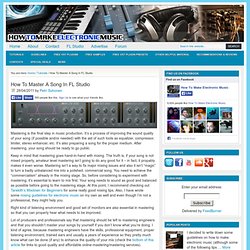
It’s a process of improving the sound quality of your song (if possible and/or needed) with the aid of such tools as equalizer, compressor, limiter, stereo enhancer, etc. It’s also preparing a song for the proper medium. After mastering, your song should be ready to go public. Keep in mind that mastering goes hand-in-hand with mixing. The truth is, if your song is not mixed properly, amateur level mastering isn’t going to do any good for it – in fact, it propably makes it even worse.
Youtube. French House: The Art of Sampling. How to Make Dubstep in Ableton Live Tutorials. In the post “5 most used softwares for making dubstep” we showed a summary of the endless debate about which software is best for creating dubstep music.

Everyone decides for themselves, but our choice is clear here – Ableton Live, we love you! Ableton Live is a sequencer and DAW for both major platforms – Mac OS and Windows. Live is built for composing and arranging, but its real potential comes to the full when we learn how to use it as an instrument. A bunch of instruments, sound modules, real time effects, intuitive work flow in user friendly interface, the architecture that allows us to create incredible sounds and atmospheres, advanced midi and audio controls and virtually inexhaustible options, variations, combinations… Besides making dubstep and any other imaginable music in it, Ableton Live is a powerful tool for DJing too…mixing, remixing, beatmatching, crossfading…basically, whatever you want. 1.
Dubstep for Beginners - Part 1: The Drums. With three equally important focal points, this tutorial series will initiate you each of these areas of dubstep and how to start producing your own grooves.
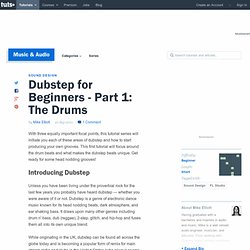
This first tutorial will focus around the drum beats and what makes the dubstep beats unique. Get ready for some head nodding grooves! Introducing Dubstep Unless you have been living under the proverbial rock for the last few years you probably have heard dubstep — whether you were aware of it or not. Dubstep is a genre of electronic dance music known for its head nodding beats, dark atmosphere, and ear shaking bass. While originating in the UK, dubstep can be found all across the globe today and is becoming a popular form of remix for main stream radio and clubs in the United States (who always seems to lag behind the times with electronic music).
Setting Up Our Project Like most genres, dubstep has certain conventions. Drum n bass ‹ Drumsallday. Learn all about the word of Drum n' Bass and how to play it live!
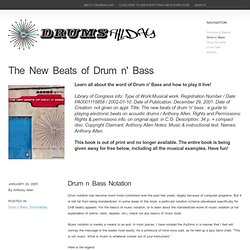
Library of Congress info: Type of Work:Musical work. Registration Number / Date: PA0001118858 / 2002-01-10. Date of Publication: December 29, 2001. Create R2D2 stye voices with Fl Studio and 3xOsc » Boyinaband Tutorials. Hi!
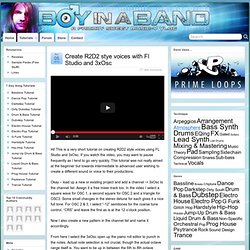
This is a very short tutorial on creating R2D2 style voices using FL Studio and 3xOsc. If you watch the video, you may want to pause frequently as I tend to go very quickly. Datsik / Excision Wobble » Boyinaband Tutorials. Disco House Basslines. Disco house basslines are unashamedly retro, harking back to the 70s heyday of white suits and platform boots.
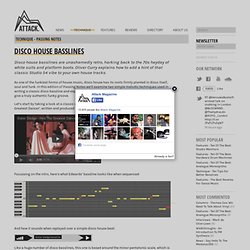
Oliver Curry explains how to add a hint of that classic Studio 54 vibe to your own house tracks. As one of the funkiest forms of house music, disco house has its roots firmly planted in disco itself, soul and funk. In this edition of Passing Notes we’ll examine two simple melodic techniques used in writing a classic disco bassline and explain how they can be applied to disco house tracks in order to give a truly authentic funky groove. Let’s start by taking a look at a classic disco bassline. We’ll focus on Sister Sledge’s 1979 hit ‘He’s The Greatest Dancer’, written and produced by Nile Rodgers and Bernard Edwards of Chic: Focussing on the intro, here’s what Edwards’ bassline looks like when sequenced:
Deep House Chords. Our composition expert explains a simple technique which will help you create deep house chord progressions with ease.
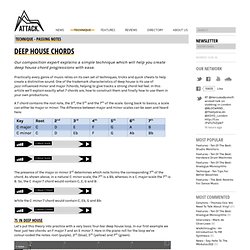
Polyrhythms. Polyrhythms in dance music are an amazingly simple way of adding complexity to your tracks.
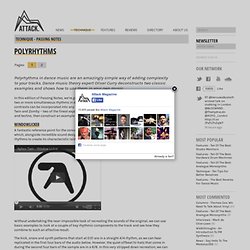
Dance music theory expert Oliver Curry deconstructs two classic examples and shows how to use them in your own music. In this edition of Passing Notes, we’re going to take a look at polyrhythms. A polyrhythm is the use of two or more simultaneous rhythms in different time signatures. As we’ll see, these rhythmic contrasts can be incorporated into any elements of a track. We’ll take a look at examples from Aphex Twin and Zomby – two of the finest exponents of polyrhythms – see how they can also work in house and techno, then construct an example from scratch. Dirty Indie-Dance. Our step-by-step drum programming walkthrough focuses on a gritty indie-dance beat with attitude.
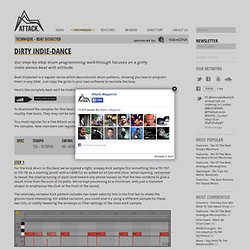
Beat Dissected is a regular series which deconstructs drum patterns, showing you how to program them in any DAW. Just copy the grids in your own software to recreate the loop. Nu-Disco: Live Groove. Our step-by-step drum programming series focuses on a loose acoustic groove with a distinct 70s flavour. Beat Dissected is a regular series which deconstructs drum patterns, showing you how to program them in any DAW. Just copy the grids in your own software to recreate the loop. Here’s the complete beat we’ll be making this week: Update Required To play the media you will need to either update your browser to a recent version or update your Flash plugin.
SPEC tempo 110—120bpm swing 50—60% sounds Analogue hits + 80s drum machine samples. Further Chords. Dance music theory expert Oliver Curry demonstrates how to break away from basic chords and create more complex harmonic structures. Way back in the very first instalment of Passing Notes we looked at some basic techniques for creating deep house chords and progressions, focusing on major and minor 7 chords.
This time, we’re going to expand on that idea and look at the construction of a number of other commonly used chords. Intervals and the construction of chords In a 7 chord, the number seven refers to the use of the seventh note of the scale. Hence, a minor 7 chord is a minor triad (root, minor 3rd and 5th) with the seventh note of the minor scale played above it. This is where chords such as 9, 11, 13 and so on get their name. If we use C major as a basic example, we can see in the keyboard diagram below that the terms 9th, 11th and 13th simply refer to the second, fourth and sixth notes of the major scale, played above the octave of the root note C.
Update Required. Beat Dissected. Eight ways to write effective backing vocals. Backing vocals are easily overlooked in the production process. Crafting Perfect Pop Backing Vocals. Great backing vocals can be essential if you want to turn a promising track into a superb one — so find out how to get them right every time. Ingmar Kiang A strong lead vocal is the star attraction on most hit records, but it's unusual for it not to be aided and abetted by a supporting cast of double-tracks, harmony lines and other backing vocals (BVs).
Far from being minor details to be thrown into the mix at the last minute, great BVs contribute hugely to the effectiveness of a tune, by adding emotion, sustaining interest, and delivering that vital punch to choruses and hooks. It makes sense, then, to lavish plenty of care and attention on your BVs. Getting Started A lead vocal will ideally be delivered as expressively and freely as possible, while respecting the melody, but this isn't usually the case for BVs. Dubstep Basics. Technique : Composing / Arranging Like drum & bass and jungle before it, dubstep showcases the inventiveness of British urban music. We explain some of its fundamental production techniques, from ‘wobbly’ bass lines to half-time drum programming.
Pete Jenkins New genres appear on an almost daily basis in electronic music, but few have had the impact of dubstep. How to Write Dubstep Music: 15 Steps. Edit Article Three Parts:Getting the GearLearning the SoftwareMaking a Song. How To Produce Pop Vocals Like The Pros. Youtube. BEST RHODES VST.....!!!!!!!!!
Well, I have tried AAS Lounge Lizard, Native Instruments EP, love Lazy Snake as well but I took the red pill six month ago and went back to Mac. Mixing Vocals : The Ultimate Guide to EQ'ing Vocals. Awesome EQ Settings Guide. 18 pro remixing tips. Remixes have been around ever since the dawn of recorded music. Early producers and engineers stripped down multitrack recordings, either to transform them from one genre to another, or to rescue a well-written but not so well-produced track from the bin.
These days, the definition of a remix has loosened somewhat as technology has raced towards the powerhouses that are our modern DAWs. How to Create Amazing Bass Patterns for Electronic Music. Twice a month we revisit some of our reader favorite posts from throughout the history of Audiotuts+. This tutorial was first published in September 2008. How to Remix: Part 6: Final Tweaks And Adjustments. Disco French House Course 05 - Filters, Phasers, Macros & Retro Disco Effects. French Filter/House sound design. How To Create Interesting Vocal Effect With Pitcher.
Youtube.